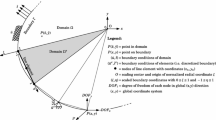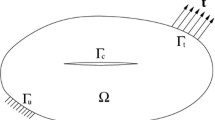Summary
The past twenty five years have shown in many ways that the BIE formulation and its BEM implementation provide important contributions in two and three dimensional fracture mechanics analysis. The Somigliana stress identity plays a key role in these many investigations and applications. The experiences show that the BIE has unique capabilities to provide analytical insights and special results for fracture mechanics problems that are not found in the finite element methods.
The success of the BIE formalism for these problems is directly derived from the fact that the BIE is a complete representation of the equilibrium equations, even in its numerical form (BEM). This experience suggests that further attempts to couple the analytical and numerical behavior of BIE's could be equally beneficial to other problem areas in mechanics.
Most recent work on fracture analysis has focused on the nature of the hypersingular form of the Somigliana stress identity. It is expected that the non-singular forms of this identity will be the basis of new work on Green's functions, focusing on the three dimensional problem.
Similar content being viewed by others
References
Aliabadi, M. H.; Rooke, D. P.; Cartwright, D. J. 1987: An improved boundary element formulation for calculating stress intensity factors: application to aerospace structures, J. Strain Anal. 22: 203–207
Ang, W. T. 1986: A boundary integral solution for the problem of multiple interacting cracks in an elastic media, Int. J. Frac., 31: 259–270
Annigeri, B. S.; Cleary, M. P. 1984: Surface integral finite element hybrid method for fracture mechanics, Intl. J. Numer. Methods Engrg., 20: 869–885
Ayres, D. J. 1970: A numerical procedure for calculating stress and deformation near a slit in a three dimensional elastic plastic solid, Engrg. Fract. Mechs., 2: 87–106
Barsoum, R. S. 1976: On the use of isoparametric finite elements in linear fracture mechanics, Int. J. Numer. Math. Engrg., 10: 25–37
Bentham, J. P. 1977: State of stress at the vertex of a quarter-infinite crack in a half space, Int. J. Solids Struct., 13: 479–492
Blandford, G. E.; Ingraffea, A. R.; Liggett, J. A. 1981: Two dimensional stress intensity factor computations using the boundary element method, Int. J. Numer. Meth. Engrg., 17: 387–404
Bui, H. D. 1977: An integral equations method for solving the problem of a plane crack or arbitrary shape, J. Mechs. Phys. Sol., 25: 29–39
Bui, H. D. 1978: Some remarks about the formulation of three-dimensional thermoelastoplastic problems by integral equations, Int. J. Solids Struct., 14: 935–939
Grouch, S. L. 1976: Solution of plane elasticity problems by the displacement discontinuity method, Int. J. Numer. Meth. Engrg., 10: 301–343
Crouch, S. L.; Starfield, A. M. 1983: Boundary Element Methods in Solid Mechanics, George Allen & Unwin, London
Cruse, T. A. 1969: Numerical solutions in three-dimensional elastostatics, Intl. J. Solids Struct., 5: 1259–1274
Cruse, T. A. 1970: Lateral constraint in a cracked, three-dimensional elastic body, Int. J. Frac. Mechs. 6: 326–328
Cruse, T. A.; VanBuren, W. 1971: Three dimensional elastic stress analysis of a fracture specimen with an edge crack, Intl. J. of Fract. Mechs., 7: 1, 1–15
Cruse, T. A. 1972: Numerical evaluation of elastic stress intensity factors by the boundary-integral equation method, in The Surface Crack: Physical Problems and Computational Solutions, ed. J. L. Swedlow, American Society of Mechanical Engineers, 153–170
Cruse, T. A. 1973: Application of the boundary-integral equation method to three dimensional stress analysis, Comp. & Struct., 3: 509–527
Cruse, T. A. 1974: An improved boundary-integral equation method for three dimensional elastic stress analysis, Comp. & Struct., 4: 741–754
Cruse, T. A. 1975: Boundary-integral equation method for three dimensional elastic fracture mechanics analysis, U.S. Air Force Report AFOSR-TR-75-0813, Accession No. ADA011660
Cruse, T. A.; Besuner, P. M., 1975: Residual life prediction for surface cracks in complex structural details, AIAA Journal of Aircraft, 12: 369–375
Cruse, T. A.; Meyers, G. J., 1977: Three dimensional fracture mechanics analysis, ASCE Journal of the Structural Division, 103: 309–320
Cruse, T. A.; Wilson, R. B. 1978a: Boundary-integral equation method for elastic fracture mechanics analysis, U.S. Air Force Report AFOSR-TR-78-0355, Accession No. ADA051992
Cruse, T. A.; Wilson, R. B., 1978b: Advanced applications of the boundary-integral equation method. Nuclear Engrg. Des., 46: 233–234
Cruse, T. A. 1978: Two-dimensional BIE fracture mechanics analysis, Appl. Math. Modeling, 2: 287–293
Cruse, T. A.; Polch, E. Z. 1986a: Elastoplastic BIE analysis of cracked plates and related problems, Parts I and II, Int. J. Numer. Meth. Engrg., 23: Part I, 429–437, Part II, 439–452
Cruse, T. A.; Polch, E. Z., 1986b. Application of an elastoplastic boundary-element method to some fracture mechanics problems, Engrg. Frac. Mechs., 23: 1085–1096
Cruse, T. A. 1987: Fracture mechanics, in Boundary Element Methods in Mechanics, ed. D.E. Beskos, Elsevier Science Publishers B.V., The Netherlands: pp. 333–365
Cruse, T. A. 1988a: Boundary Element Analysis in Computational Fracture Mechanics, Kluwer Academic Publishers, Amsterdam
Cruse, T. A. 1988b: Three dimensional elastic surface cracks, in Fracture mechanics: Nineteenth Symposium, ASTM STP 969, ed. by T.A. Cruse, American Society for Testing and Materials, Philadelphia: 19–42
Cruse, T. A.; Raveendra, S. T., 1988a: A general solution procedure for fracture mechanics weight function evaluation based on the boundary element method, Comp. Mechs., 3: 157–166
Cruse, T. A.; Raveendra, S. T. 1988b: A comparison of long and short crack elastoplastic response using the boundary element method, Engrg. Frac. Mechs., 30: 59–75
Cruse, T. A.; Novati, G. 1992: Traction BIE formulations and applications to nonplaner and multiple cracks, Fracture Mechanics: Twenty-Second Symposium (Vol. II), ASTM STP 1131, ed. S.N. Atluri et al., American Society for Testing and Materials, Philadelphia: 314–332
Cruse, T. A.; Suwito, W. 1993: On the Somigliana stress identity in elasticity, Comp. Mechs., 11: 1–10
Cruse, T. A.; Richardson, J. D. 1996: The non-singular Somigliana stress-BIE, Int. J. Numer. Meth. Engrg., in press
Eshelby, J. D.; Reed, W. T.; Shockley, W., 1957: Anisotropic elasticity with applications to dislocation theory, Acta Metal., 1: 251–259
Gangming, L.; Youngyuan, Z., 1988: Application of boundary element method with singular and isoparametric elements in three dimensional crack problems, Engrg. Frac. Mechs., 29: 97–106
Green, A. E.; Sneddon, I. N., 1950: The stress distribution in the neighborhood of a flat elliptical crack in an elastic solid, Proc. Cambridge Phil. Soc., 46: 159–163
Griffith, A. A. 1920: The phenomenon of rupture and flow in solids, Phil. Trans. R. Soc., A, 221: 163–198
Guidera, J. T.; Lardner, R. W., 1975: Penny-shaped cracks, J. Elas., 5: 59–73
Krishnasamy, G.; Rizzo, F. J.; Rudolphi, T. J., 1992: Continuity requirements for density functions in the boundary integral equation method, Comp. Mechs., 9: pp. 267–284
Hack, J. E., Chan, K. S.; Cardinal, J. W., 1985: The prediction of the crack opening behavior of part-through fatigue cracks under the influence of surface residual stresses, Engrg. Fract. Mechs., 21: 75–83
Heliot, J.; Labbens, R. C. 1979: Results for benchmark problem 1: the surface flaw, Int. J. Fract. 15: R197-R202
Huang, Q.; Cruse, T. A. 1994: On the nonsingular traction-BIE in elasticity, Int. J. Numer. Meth. Engrg., 37: 2041–2072
Inglis, C. E., 1913: Stresses in a plate due to the presence of cracks and sharp corners, Proceedings of the Institute of Naval Architects, 60: 219–230
Irwin, G. R. 1957: Analysis of stresses and strains near the end of a crack traversing a plate, J. Appl. Mechs., 24: 361–364
Kim, J.-W. 1985: A contour integral computation of stress intensity factors in the cracked orthotropic elastic plates, Engrg. Fract. Mechs., 21: 353–364
Lachat, J. C.; Watson, J. O. 1976: Effective numerical treatment of boundary integral equations: a formulation for three-dimensional elastoplastics, Int. J. Numer. Meth. Engrg., 10: 991–1005
Li, R.; Chudnovsky, A. 1994: The stress intensity factor Green's function for a crack interacting with a circular inclusion, Int. J. Fract., 67: 169–177
Martin, P. A. 1982: The discontinuity in the elastostatic displacement vector across a penny-shaped crack under arbitrary loads, J. Elas., 12: 201–218
Melnikov, Yu. A. 1995: Green's Functions in Applied Mechanics, Computational Mechanics Publications, Southampton UK
Mukherjee, S., 1982: Boundary Element Methods in Creep and Fracture, Applied Science, Essex UK
Polch, E. Z.; Cruse, T. A.; Huang, C.-J. 1987: Traction BIE solutions forflat cracks, Comp. Mechs., 2: 253–267
Putot, C. J., 1980: Une nouvelle methode d'equations integrales pour certains problems de fissures planes, Ph.D. Thesis, University Pierre et Marie Curie, Paris VI
Raveendra, S. T.; Cruse, T. A. 1989: BEM analysis of problems of fracture mechanics, in Industrial Applications of Boundary Element Methods, ed. P. K. Banerjee; R. B. Wilson, Elsevier Applied Science, London, 186–204
Raju, I. S.; Newman, Jr., J. C. 1977: Three dimensional finite element analysis of finite thickness fracture specimens, NASA Technical Note TN D-8414, Washington, D. C.
Rudolphi, T. J.; Koo, L. S. 1985: Boundary element solutions of multiple, interacting crack problems in plane elastic media, Engrg. Anal., 2: 211–216
Schmitz, H.; Volk, K.; Wendland, W. 1993: Three-dimensional singularities of elastic fields near vertices, Numer. Meth. P. Diff. Eqtns., 9: 323–337
Sinclair, J. E.; Hirth, J. P. 1975: Two dimensional elastic Green function for a cracked anisotropic body, J. Phys. F Metal Phys., 5: 236–246
Snyder, M. D.; Cruse, T. A. 1975: Boundary-integral equation analysis of cracked anisotropic plates, Intl. J. of Fract. Mechs., 11: 2, 315–328
Stern, M.; Becker, E. B.; Dunham, R. S. 1976: A contour integral computation of mixed-mode stress intensity factors, Int. J. Fract., 12: 359–368
Swedlow, J. L.; Cruse, T. A. 1971: Formulation of the boundary integral equation for three-dimensional elasto-plastic flow, Int. J. Solids Struct., 7: 1673–1683
Tan, C. L.; Fenner, R. T. 1979: Elastic fracture mechanics analysis by the boundary integral equation method, Proc. R. Soc. Lond. A, 369: 243–260
Tanaka, M.; Itoh, H. 1987: New crack elements for boundary element analysis of elastostatics considering arbitrary stress singularities, Appl. Math. Model., 11: 357–363
Telles, J. C. F. 1983: The Boundary Element Method Applied to Inelastic Problems, Vol. 1 in the series Lecture Notes in Engineering, ed. C. Brebbia and S. A. Orzag, Springer-Verlag, Berlin
Tracey, D. M. 1971: Finite elements for determination of crack tip elastic stress intensity factors, Engrg. Fract. Mechs., 3: 255–265
Williams, M. L. 1952: Stress singularities resulting from various boundary conditions in angular corners of plates in extension, J. Appl. Mechs., 19: 526–528
Weaver, J. 1977: Three dimensional crack analysis, Intl. J. Soc. Struct., 13: 321–330
Weeën, F. van der, 1983: Mixed mode fracture analysis of rectilinear anisotropic plates using singular boundary elements, Comp. & Struct., 17: 469–474
Xanthis, L. S.; Bernal, M. J. M.; Atkinson, C. 1981: The treatment of singularities in the calculation of stress intensity factors using the boundary integral equation method, Comp. Meth. Appl. Mechs. Engrg., 26: 285–304
Author information
Authors and Affiliations
Additional information
Communicated by S. N. Atluri, 4 January 1996
Dedicated to the 10th anniversary of Computational Mechanics
Rights and permissions
About this article
Cite this article
Cruse, T.A. BIE fracture mechanics analysis: 25 years of developments. Computational Mechanics 18, 1–11 (1996). https://doi.org/10.1007/BF00384172
Issue Date:
DOI: https://doi.org/10.1007/BF00384172




